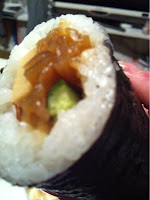Yes, as you can see they have conveyor belts of sushi, but what may surprise you to find out is that they don't really do the "roll" type of sushi that you often find in America. Here, it is your typical fish on rice. There are a few as you can see that are Nori, Rice, and Seafood-substance ( like the Seafood Salad that you see coming up). Another popular one is egg. It can be hard boiled or fried, but mostly people stick to fish.
Rules for eating sushi
- When eating at a small restaurant where a chef makes it in front of you, do not add too much wasabi. It is considered a bit offensive to the chef. Like how in Chicago some places don't serve ketchup with their hot dogs, they have a unique style and know the best taste for it.
- As for the wasabi, it is a common style that I have seen (and by that, I mean the only style) to remove the fish from the rice, add a small amount of wasabi and sometimes a few drops of soy (which you can add after the fish has been replaced if you prefer), and then replace the fish. If you are at a restaurant where the chef styles and makes the sushi in front of you, he may already add the wasabi in what he considers if the perfect balance of spice and fish.
- Do not add the wasabi to the soy sauce dish.
- Eat it in one bite. Ok. This is a bit obvious, but really...you just try taking two bites and making it look graceful and unmessy. Yeah, that's what I thought. So take two bites.
- Many people will advise you to make a small dish of soy for dipping. However, I have found that it is commonplace and perfectly acceptable (at least in restaurants such as the one below) to pour the soy sauce directly onto the sushi. You only add a few drops and definitely not to much. But this method prevents too much waste of the soy sauce and you wont leave any grains of rice afloat in the soy sauce dish. Another note, is that some will advise you to only dip the fish in the dish of soy sauce and not the entire nigiri, as the rice will soak up too much soy (and also leave rice grains afloat)
- Speaking of that, don't leave any grains of rice in the soy sauce dish. It is unavoidable for some, but it is not seen as proper etiquette.
- Where I have heard it is alright to eat sushi with your hands to eat in some restaurants. I have not seen this. And prefer to always use chopsticks...May Buddha smite you if you use any other utensil.
- The ginger. There is no advisable amount for this. Often when I go to a restaurant with a Japanese friend we can clear out half a container of this if not more. This is considered as a palate cleanser, and is eaten between bites of different sushi. This is so that you get the full effect and flavor of the new sushi you are sampling so you can enjoy it to its fullest effect without having a cross contamination of flavors.
















